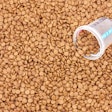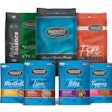.jpg?auto=format%2Ccompress&q=70&w=400)
Why are petfood manufacturers touting "wild" ingredients? Promotional material for Eukanuba's Naturally Wild products sums it up this way: "Before dogs were domesticated, meat was their key source of nutrition. Inspired by a dog's heritage and nutritional needs, Eukanuba Naturally Wild was developed to nourish every dog as nature intended." Sounds good, but the science is not always clear as to what nature intended.
Unbiased scientific research on canine and feline ancestral diets has unlocked and will continue to unlock important innovations. However, sometimes marketing the concept of wild, ancestral petfoods gets ahead of the science. With that caveat, let's look at some of the wild petfood diets that are becoming more popular.
Wild assertions
Marketers of wild-ingredient-based dog and cat foods say they provide a diet rich in quality meat with high nutrient bioavailability-the way nature intended. Oher claims include:
- "We use a savory fresh protein from US Department of Agriculture inspected sources as the number one ingredient, and quality, low-ash chicken meal as the number two ingredient."
- "It's a return to your dog's ancestral diet while recognizing its modern day lifestyle. We use only meat protein sources, healthy fruits and vegetables-no grains, fillers, by-products or artificial colors, flavors or preservatives."
- In addition, the standard claims and disclaimers tend to apply: no grain, no by-products, roasted meat, fish and poultry, all natural, no artificial preservatives, colors or flavors, no corn, no wheat, no soy, no gluten, no fillers, chicory root for digestive support, antioxidants to protect cells, the ideal blend of omega fatty acids and chelated minerals.
For the most part, proponents of wild-ingredient products believe the ideal diet is the pre-agricultural diet on which a species evolved. They say such diets contain the foods that best suit the species' digestive and metabolic systems and are least likely of all foods to cause an allergic reaction.
Eukanuba Naturally Wild
Iams Eukanuba's entry into the wild petfood segment implies that there's good market research supporting the concept. Procter & Gamble, the company's parent, is famous for being a highly skilled, careful marketer-so you can bet that a lot of market research went into the idea. Products include:
- North Atlantic Salmon & Rice Formula;
- Country-Grown Turkey & MultiGrain Formula; and
- New Zealand Venison & Potato Formula.
Evolution petfood
An early example of wild petfood marketing is the Evolution Diet Pet Food Corp ., which started in 1987. It's not typical of most wild petfoods in that the products are vegetarian. I remain confused, but the company's name begs for it to be included.
Founder and CEO Eric Weisman says he founded the company after examining what went into conventional petfoods and deciding he wanted a "better alternative" for his own pets. His dogs and cats were having health issues he thought were related to the ingredients in conventional petfoods.
Weisman worked with Darwin Brightsman, PhD, an animal nutritionist, to formulate Evolution Diet Pet Food products. At the time, Weisman was a physician in private practice using vitamin, botanical, nutraceutical and nutrition therapy for people. Weisman notes he is still using "state-of-the-art combinations" of vitamins, herbs and nutraceuticals developed to treat joint, vascular and other diseases in sick pets at the Evolution Diet Rescue facility, which he has operated in St. Paul, Minnesota, USA, since 1987.
Before Grain
Merrick , maker of Before Grain products, asserts that dogs and cats do better when fed grain-free diets. This is, they say, what nature intended. The company says a diet based primarily on fresh meat, blue fruit, nutrient-dense vegetables and high-quality meat contributes to better health and longevity. Ingredients used include buffalo, beef, chicken, salmon, turkey and tripe.
Merrick points out enthusiastically that Before Grain products contain acai, an Amazon palm berry, and blueberries. Freeze-dried acai berries and blueberries are "carefully added to the kibble after the cooking process." Merrick contends these "super blue fruits" are high in antioxidants and anthocyanins.
Taste of the Wild
"Years of domestication have turned pets from fierce predators to best friends," contends Taste of the Wild Pet Foods. "However, modern science proves that dogs and cats still share the DNA of the wolf or wild cat. Taste of the Wild Brand Dog and Cat Food offers pets a diet dictated by genes. It allows pet owners to provide their pets the kind of natural, balanced diet that they could find in the wild."
The company has four dry formulas:
- High Prairie Canine Formula with Roasted Bison & Roasted Venison;
- Pacific Stream Canine Formula with Smoked Salmon;
- Wetlands Canine Formula with Roasted Wild Fowl; and
- Rocky Mountain Feline Formula with Roasted Venison & Smoked Salmon.
Canidae All Natural
Canidae All Natural Pet Foods offers grain-free formulas for dogs and cats. Most contain 80% protein and 20% fruits and vegetables, "designed to increase energy levels." The products contain no corn, wheat, soy, grain fractions, glutens or fillers, says the company.
Those who market wild-ingredient products believe the ideal diet is a pre-agricultural diet. This diet, they say, contains the foods that best suit digestive and metabolic systems and are least likely to cause an allergic reaction. It's an appealing idea, but the jury is still out.

.jpg?auto=format%2Ccompress&fit=crop&h=167&q=70&w=250)
.jpg?auto=format%2Ccompress&fit=crop&h=167&q=70&w=250)
.jpg?auto=format%2Ccompress&fit=crop&h=167&q=70&w=250)













